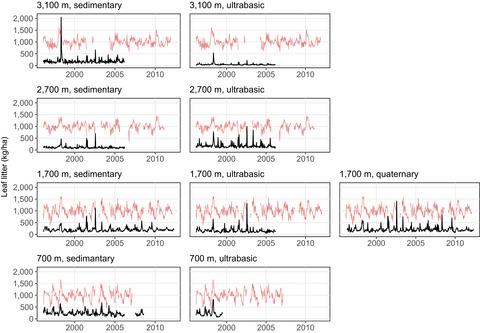Our official English website, www.x-mol.net, welcomes your
feedback! (Note: you will need to create a separate account there.)
Temperature is a dominant driver of distinct annual seasonality of leaf litter production of equatorial tropical rain forests
Journal of Ecology ( IF 5.3 ) Pub Date : 2020-10-04 , DOI: 10.1111/1365-2745.13500 Kanehiro Kitayama 1 , Masayuki Ushio 2, 3 , Shin‐Ichiro Aiba 4
中文翻译:

温度是赤道热带雨林叶片凋落物产生的不同年度季节性的主要驱动因素
更新日期:2020-10-04
Journal of Ecology ( IF 5.3 ) Pub Date : 2020-10-04 , DOI: 10.1111/1365-2745.13500 Kanehiro Kitayama 1 , Masayuki Ushio 2, 3 , Shin‐Ichiro Aiba 4
Affiliation

|
- Intra‐annual periodicity of canopy photosynthetic activity and leaf development has been documented in seasonal and weakly seasonal tropical forests in the Amazon and elsewhere. However, vegetative periodicity such as leaf flush and fall in apparently ‘aseasonal’ equatorial tropical forests has not been well documented. Moreover, causal drivers of the vegetative periodicity in those forests have not been identified largely because of the difficulty in performing manipulative experiments targeting whole forest ecosystem dynamics.
- Here we show a distinct annual seasonality in canopy dynamics using a Fourier analysis with a statistical significance test on the long‐term, fortnightly monitored dataset of leaf litterfall in nine evergreen tropical rain forests on Mount Kinabalu, Borneo. Statistically significant annual periodicity occurs across elevations and soil types in all years irrespective of the year‐to‐year climatic variability, suggesting that fluctuations in regional climate rather than local micro‐climatic, edaphic and/or biotic conditions cause the precise 1‐year periodicity.
- We examine climatic factors that have causative effects on the distinct 1‐year periodicity using the spectrum convergent cross mapping that we developed in the present study that can distinguish causal relationships from seasonality‐driven synchronization. According to the analysis, we find that mean daily air temperature is most strongly, causatively related to the 1‐year periodicity of leaf litterfall. However, knowledge on ecophysiolocial and molecular mechanisms underlying temperature‐control of tropical tree growth is limited and further studies are required to understand the detailed mechanisms.
- Synthesis. We suggest that intra‐annual temperature changes in association with the movement of the intertropical convergence zone cause the distinct annual vegetative periodicity. Because vegetative periodicity can be transmitted to the dynamics of higher trophic levels through a trophic cascade, interactions between vegetative periodicity and daily air temperature, not rainfall, would more strongly cause changes in the dynamics of equatorial tropical rain forests. Our results show that clear vegetative periodicity (i.e. annual seasonality) can be found in equatorial tropical rain forests under diverse local environments, and that air temperature is a more important factor than the other climate variables in the climate–forest ecosystem interactions.
中文翻译:

温度是赤道热带雨林叶片凋落物产生的不同年度季节性的主要驱动因素
- 在亚马逊地区和其他地方的季节性和弱季节热带森林中,冠层光合作用和叶片发育的年内周期性已有记录。然而,营养周期性的变化,如叶子潮红和掉落在显然是“季节性”的赤道热带森林中,尚未得到充分的记录。此外,由于难以进行针对整个森林生态系统动态的操纵性实验,因此尚未确定这些森林中营养周期性的因果驱动因素。
- 在这里,我们使用傅立叶分析和婆罗洲京那巴鲁山的9个常绿热带雨林的每两周监测一次的落叶凋落数据集进行了傅立叶分析和统计学显着性检验,显示了冠层动态的不同年度季节性。与逐年的气候变化无关,所有年份的海拔和土壤类型均发生具有统计意义的年度周期性,这表明区域气候的波动而不是局部的微气候,海平面和/或生物条件导致精确的1年周期性。
- 我们使用我们在本研究中开发的能将因果关系与季节性驱动的同步区分开来的频谱收敛交叉映射法,研究了对明显的1年周期性具有因果关系的气候因素。根据分析,我们发现平均每日气温最强,与叶片凋落物的1年周期相关。然而,对热带树木生长的温度控制基础的生态生理和分子机制的知识是有限的,需要进一步研究以了解详细的机制。
- 综合。我们认为,年际温度变化与热带辐合带的运动有关会引起明显的年度营养周期性。由于营养周期性可以通过营养级联传递给较高营养级的动力学,因此营养周期性与每日气温(而非降雨)之间的相互作用会更强烈地引起赤道热带雨林的动力学变化。我们的结果表明,在不同的局部环境下,赤道热带雨林具有明显的营养周期性(即年度季节性),而且在气候-森林生态系统相互作用中,气温是比其他气候变量更重要的因素。











































 京公网安备 11010802027423号
京公网安备 11010802027423号